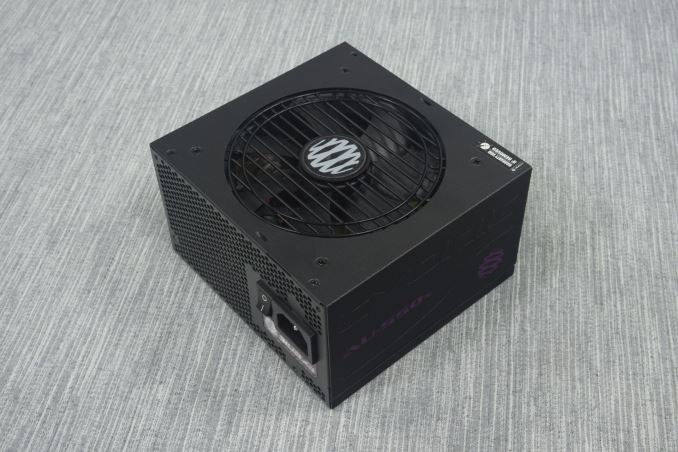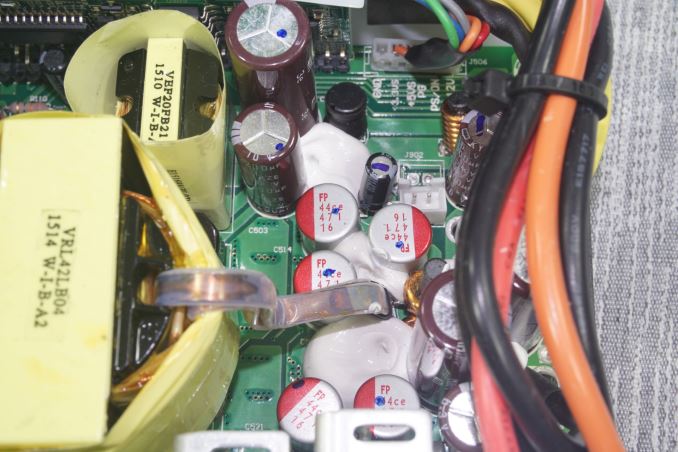The Cyonic AU-550x PSU Review
by E. Fylladitakis on August 17, 2015 8:00 AM EST- Posted in
- Cases/Cooling/PSUs
- Seasonic
- PSUs
- 550W
- Cyonic
Conclusion
In our humble opinion, Cyonic started off the right foot as a company. Instead of starting with very high power products, like many other companies did before, they opted to focus on just a few high performance 450-650 Watt PSUs. This power range is where the needs of the vast majority of PC users lie. A typical home/office PC would hardly ever reach a demand greater than 200 Watts and even a good gaming system with a single GPU should not require more than 400-450 Watts at peak power. As all switching PSUs operate best at about 50% load, the Cyonic models are ideal for such systems.
The overall performance of the AU-550x came as a little surprise to us. When we saw the minimal heatsinks and the modified platform, we initially expected it to perform worse than the Seasonic G-series model. True enough, the thermal performance of the AU-550x is slightly worse and it does get a little warmer when it is heavily stressed. However, to our surprise and despite the presence of the secondary vertical PCB and all the losses associated with the extra connections/cables, the Cyonic AU-550x is still a little more efficient than the standard platform it is based on. It also resists very high temperatures and can still deliver very good performance under very harsh conditions. The higher efficiency combats the heatsink mass reduction and allows the Cyonic AU-550x to maintain very low noise levels. The company could make the thermal control of the PSU more aggressive, with the fan speeding up faster and forcing it to maintain lower internal temperatures, but opted for excellent acoustics performance instead. Considering the very high quality components that this PSU is made of, we believe that is was a good trade-off.
When it comes to electrical performance, we were bewildered to see the massive difference between the minor voltage lines and the main 12V line. We had to repeat our tests several times just to make sure. The filtering of the 3.3V/5V lines is one of the best that we have ever seen, if not the best, with our instruments hardly capable of recording any ripple at all. On the other hand, the 12V line is well filtered, but nowhere near as perfectly as the minor voltage lines. The presence of very high quality capacitors throughout the design makes this even stranger, as it implies that the ripple does not come from the mediocre capabilities of an average capacitor. Nevertheless, even the maximum ripple that the 12 V line displayed was half that of the ATX design limit, so we should stress that this is not really a problem, just a peculiar characteristic of this particular PSU.
In summary, the Cyonic AU-550x does very well and we feel that the newly founded company started off with some very interesting products that are targeted at a wide audience. With a retail price of $90 plus shipping, the Cyonic AU-550x is well-priced as well. Most quality 80Plus Gold certified 550 Watts PSUs are currently retailing for $80-120, so that does not make the Cyonic AU-550x an astonishing deal but, considering its performance, quality and design, it certainly earns our recommendation.












30 Comments
View All Comments
marraco - Monday, August 17, 2015 - link
Anandtech needs to learn a lot about reviewing a PSU.Where are the power on tests? They are critical.
How does it behaves when each rail is fully loaded? Does it really deliver? Most PSU don't.
How much AC noise and ripple contains the signal under different loads? Those small peaks may slowly erode your hardware
E.Fyll - Monday, August 17, 2015 - link
By "Power On" tests, I assume that you are talking about the AC input and care about the inrush current and harmonics.Power On tests require a very good oscilloscope with current probes and a programmable AC source. These are equipment in the tens of thousands of dollars. Although there are plans to purchase them in the future, you need to excuse me that I do not possess such funds to spend for just a couple of more tests.
...and not practically useful tests either. Power On tests are everything but "critical". They are virtually limited to compliance certification. The inrush current or the harmonics generated by a PSU will not affect its performance. Harmonics may affect other very sensitive devices on the same line, such as audio equipment, but again these need to reach extraordinary levels to become an issue. Inrush current could cause your household circuit breaker to release if it is too high, but 99.99999999% of the readers cannot really calculate and compare the current-time (I-t) curve of a PSU against the I-t curve of the circuit breaker. If I gave them a curve with a maximum current of 170A over a few nanoseconds, most people would think that their house would catch fire, even though that figure is entirely unimportant. 99.99% cannot even differentiate between power and energy, they cannot comprehend that timeless figures do not tell any side of the story at all.
Now, if you are talking on the DC side, they become critical only if they fail their required specifications. It is very difficult for a PSU not to meet these standards. Once again, a very fast oscilloscope is required for proper testing, but I would report it if something was amiss with the oscilloscope that I am using right now.
The vast majority (99.9% or more) of the PSUs will behave just fine with each rail loaded to its maximum wattage and current specifications. Heavy ripple may appear due to the cross-loading, but I never saw a single PSU that would not work. We have the cross-loading tests just for that. And, by the way, loading a single rail to the maximum while the rest are unloaded is not a proper usage scenario. By that logic, I should be testing them on mount Everest, just to see if they can work at an altitude of 5000 meters. Even for our cross loading tests, the load is terribly unbalanced and it is virtually impossible to represent a real world scenario. Well, unless if what you want to do is to use a PSU to start a car's engine or to power a welder.
And since we are on the topic of learning, you can have AC signal on your DC signal (that's ripple) and random fluctuations (that's noise). Page 4 for ripple. For noise, once again you need a VERY expensive oscilloscope, capable of calculating and displaying ripple and noise separately. My equipment cannot currently filter the noise out of a signal.
And yes, ripple is one of the most important PSU characteristics in my opinion, as it has a significant effect on the lifetime of electronics.
ImSpartacus - Tuesday, August 18, 2015 - link
Whoa, let's calm down there, hondo.It's not worth arguing with random people on the internet.
It's good to read comments and feedback, but spend your time writing articles, not massive comments.
dqniel - Tuesday, August 18, 2015 - link
His comment was filled with useful information, so I'm glad he posted it.marraco - Monday, August 24, 2015 - link
Thanks for your answer.I apologize, because for some reason I didn't noticed the ripple data in page 4. Thanks for including it.
Some sites specialized on PSU analysis compare each unit with the certificated specification standards, and other units.
I learnt about the importance of ripple and power on behavior when one of my motherboards died, and a friend told me that my PSU had bad behavior, so the ripple probably damaged it enough for the bad peaks at power on to finish the work.
He was working at a university, so he didn’t pay for the equipment. I didn’t knew that it was so expensive.
I'm sorry to hear that you do not have that expensive equipment. I'm accostumed to find here reviews of expensive hardware, and forgot that generally it is lendt or donated by manufacturers.
kuttan - Monday, August 24, 2015 - link
No worry here a good review which is easy to understand and informative. So sites go too much technical in a sense that you need to poses a PhD in electrical science to understand what they say. Some sites do review the opposite way that they do some basic load tests and efficiency tests I'm not naming it who. Anandtech PSU reviews are overall balanced and yet detailed enough.Folterknecht - Monday, August 17, 2015 - link
Can't remember when/if I saw a Seasonic (based) PSU with 60 mV Ripple, that usually their strong point - bad Sample?@jonnyGURU:
If you 're working for Corsair now - that's at least what I assume after seeing you in a Techsyndikate Interview regarding single/multi rail designs "recently" - commenting on on a competitiors product seems odd to me.
sheh - Tuesday, August 18, 2015 - link
I still think it would be useful to test with a 50W load, and even 25W. Modern computers don't use much power in light usage.Beaver M. - Tuesday, August 18, 2015 - link
Exactly. A test like that is mandatory nowadays. You can actually get systems down to 10-15W, if you put some effort into it.DanNeely - Wednesday, August 19, 2015 - link
It was tested at a sub 50W load. Eyeballing it I'd say it's at most 30W; might only be 25.